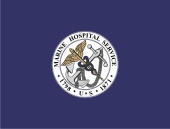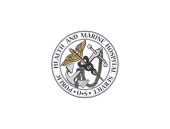Marine Hospital Service
The Marine Hospital Service was an organization of Marine Hospitals dedicated to the care of ill and disabled seamen in the United States Merchant Marine, the U.S. Coast Guard and other federal beneficiaries. The Marine Hospital Service evolved into the U.S. Public Health Service Commissioned Corps.
It was the point of origin for the Public Health Service and the Public Health Service Commissioned Corps of the present-day Department of Health and Human Services, and current Operating Divisions (OPDIV) and Staffing Divisions that include the National Institutes of Health, the Centers for Disease Control and Prevention, Indian Health Service, and a host of other federal-level health programs.
History
Founding
.jpg)
The origins of the Marine Hospital Service can be traced to the passage, by the 5th Congress of the United States, of "An Act for the Relief of Sick and Disabled Seamen" in 1798. This act created Marine Hospitals to care for sick seamen. They were initially located along the East Coast, at the harbors of the major port cities, with Boston being the site of the first such facility, followed later by others including in the Baltimore vicinity at Curtis Bay.[1][2] The Marine Hospital Service was placed under the Revenue Marine Service (a forerunner of the present-day Coast Guard) within the Department of the Treasury.[3]
It was the first federal health law.[2] It authorized a tax, which was the deduction of twenty cents per month from the wages of the seamen.[4] This tax raised funds for physicians and to support the network of hospitals.[5] Funding for the hospitals was provided by a mandatory tax of about 1% of the wages of all maritime sailors.[1][6] (In 1884, the tax was abolished and in 1906 funds were dispensed by Congress.)
The act led to the gradual creation of a network of hospitals along coastal and inland waterways.[7] At the time the act was passed the east coast was the only shore with harbors. As the boundaries of the United States expanded, and harbors were built on other coasts, so too were marine hospitals. In the 1830s and 1840s they were built along inland waterways, the Great Lakes, and the Gulf of Mexico. After the acquisition of the Oregon Territory (1846) and California (1848) hospitals were built in 1850s at Pacific Coast harbors.[1]
Reorganization


Following the Civil War, public outcry and scandal surrounded the Marine Hospital Fund. In 1869, Dr. John Shaw Billings, a prominent Army surgeon, was appointed to head an investigation of the Marine Hospital Fund. Dr. Billings found the hospital fund to be inadequate and completely disorganized.
In June 1870 the 41st Congress formally converted the loose network of locally controlled marine hospitals, the Marine Hospital Fund, into a centrally controlled Marine Hospital Service, with its headquarters in Washington, D.C. This reorganization made the Marine Hospital Service into its own bureau within the Department of the Treasury.[3]
Dr. John Maynard Woodworth was subsequently appointed to the Service as "Supervising Surgeon." He transformed the service into a disciplined organization based on his experience in the Union Army as a surgeon. Dr. Woodworth required his physicians to be a mobile work force stationed where the service was in need, and he mandated the daily wear uniforms. This eventually led to the creation of the modern-day Public Health Service Commissioned Corps. Dr. Woodworth, using Army-style heraldry, created the Marine Hospital Service fouled anchor and caduceus seal which is used to this day by the Public Health Service. In 1873, Dr. Woodworth's title was changed to "Supervising Surgeon General," a forerunner of the modern-day office of Surgeon General of the United States.[8]
Woodworth created a cadre of mobile, career service physicians, who could be assigned as needed to the various Marine Hospitals. The commissioned officer corps was established by legislation in 1889, and signed by President Grover Cleveland. At first open only to physicians, over the course of the 20th century, the Corps expanded to include veterinarians, dentists, physician assistants, sanitary engineers, pharmacists, nurses, environmental health officers, scientists, and other types of health professionals. It is now known as the Commissioned Corps of the U.S. Public Health Service.
Increasing scope

The scope of activities of the Marine Hospital Service began to expand well beyond the care of merchant seamen in the closing decades of the nineteenth century, beginning with the control of infectious disease. Starting in the mid-14th century, ships entering harbors were quarantined when any of the crew was sick. This practice was normal procedure at United States harbors, with quarantine originally a function of the individual states, rather than of the Federal Government. The National Quarantine Act of 1878 vested quarantine authority to the Marine Hospital Service. and the National Board of Health. The National Board was not reauthorized by Congress in 1883 and its powers reverted to the Marine Hospital Service.[9] Over the next half a century, the Marine Hospital Service increasingly took over quarantine functions from individual state authorities.
The Marine Hospitals, as their name suggests, were hospitals constructed at key sea and river ports across the nation to provide health care for merchant marine sailors. Aside from the well-being of these sailors, the hospitals provided a key monitoring and gate-keeping function against pathogenic diseases.[3] As immigration increased dramatically in the late 19th century, the Federal Government also took over the processing of immigrants from the individual states, beginning in 1891. The Marine Hospital Service was assigned the responsibility for the medical inspection of arriving immigrants at sites such as Ellis Island in New York Harbor. Commissioned officers played a major role in fulfilling the Service's commitment to prevent disease from entering the country.
As the nation grew, the scope of Marine Hospital Service's scope of duties grew to include domestic and foreign quarantine and other national public health functions. Over time, the hospitals of the service were also expanded to include research and prevention work as well as the care of patients. Aside from merchant seamen, members of the military, immigrants, Native Americans, other federal beneficiaries, and people affected by chronic and epidemic diseases found a source for health care in the PHS and its hospitals.
Transformation into Public Health Service

In 1902, the Marine Hospital Service was renamed the "Public Health and Marine-Hospital Service." In 1912, as the emphasis of its responsibilities shifted from sailors to general public health and with the decommissioning of various old marine hospitals, the name was changed again to the "Public Health Service" to encompass its diverse and changing mission.
As a result of the Reorganization Act of 1939, the Public Health Service was transferred from the Department of the Treasury into the new Federal Security Agency.[10] All of the laws affecting the functions of the public health agencies were consolidated for the first time in the Public Health Service Act of 1944.[3] In 1953 the Federal Security Agency was replaced with the newly formed Department of Health, Education and Welfare, which was later renamed the Department of Health and Human Services in 1980.
Today, the records for these institutions sit in storage at the National Library of Medicine in Bethesda, Maryland and the National Archives in College Park, Maryland.
Buildings
The hospitals themselves were, by the middle of the 19th century, fairly imposing and architecturally grand structures in many cases. As long as ample federal funding was available for their construction, these hospitals were impressive examples of government-provided health care. The hospitals of the early 20th century in major port cities such as New Orleans, San Francisco, and Savannah displayed ornate architectural detail and reflected many of the changes sweeping medicine at the time.
During the Nixon administration, funding was cut to the PHS hospitals program and many of these institutions closed or were turned over to local public health offices. Eight survived as federal institutions until the early 1980s, when further budget cuts put an end to their funding. Some, such as the one in Savannah, Georgia, continued as outpatient low-income health clinics up to 2003 while others, such as the large hospital in San Francisco on the grounds of the US Army Presidio, were diverted to other Federal and military uses. In the case of the Presidio, the PHS Hospital was used as a site for language training for military officers in the late 1980s.
See also
References
- Gostin, Lawrence O. (2008). "Box 8: The Federal Presence in Public Health". Public Health Law: Power, Duty, Restraint, Revised and Expanded (2nd ed.). University of California Press. p. 156. ISBN 978-0520253766. Retrieved November 8, 2012.
- "Public Health". marinehospital.org. Retrieved March 7, 2018.
- "Images From the History of the Public Health Service: Introduction". nlm.nih.gov. Retrieved December 3, 2017.
- "Justice Network - Sick and Disabled Seaman Act of 1798 Govt. Healthcare". nosue.org. Retrieved March 7, 2018.
- "Public Health in the United States". sphweb.bumc.bu.edu. Retrieved March 7, 2018.
- Ungar, Rick (January 17, 2011). "Congress Passes Socialized Medicine and Mandates Health Insurance -In 1798". Forbes.com. Retrieved November 8, 2012.
- "https://www.usphs.gov/aboutus/history.aspx". usphs.gov. Retrieved March 7, 2018. External link in
|title=(help) - ASPA. "John Maynard Woodworth (1871-1879)". surgeongeneral.gov. Archived from the original on December 1, 2017. Retrieved December 3, 2017.
- Smillie, W. G. "The National Board of Health, 1879-1883" American Journal of Public Health and The Nation's Health (1943) 33(8):925-930.
- "Message to Congress on the Reorganization Act". The American Presidency Project. April 25, 1939. Retrieved October 23, 2018.
External links
| Wikimedia Commons has media related to United States Marine Hospitals. |
| Wikisource has the text of the 1905 New International Encyclopedia article Marine Hospital Service. |
- The National Library of Medicine has a guide to the documents culled from various PHS hospitals when these closed.
- marinehospital.org- Website of the U.S. Hospital Foundation, which is restoring the Marine Hospital in Louisville, Kentucky.
- History Of National Institution Of Health